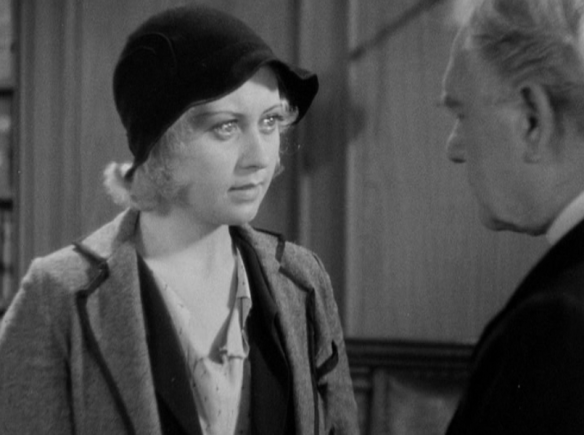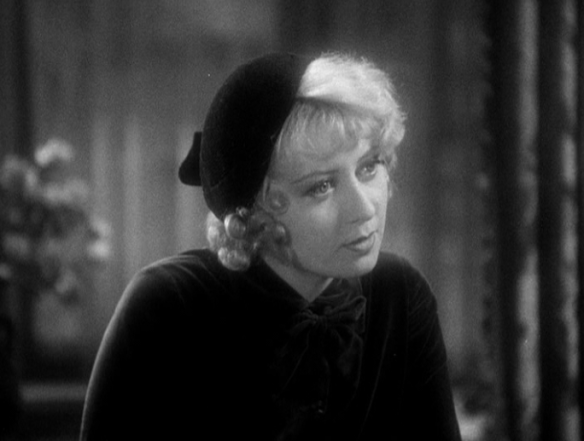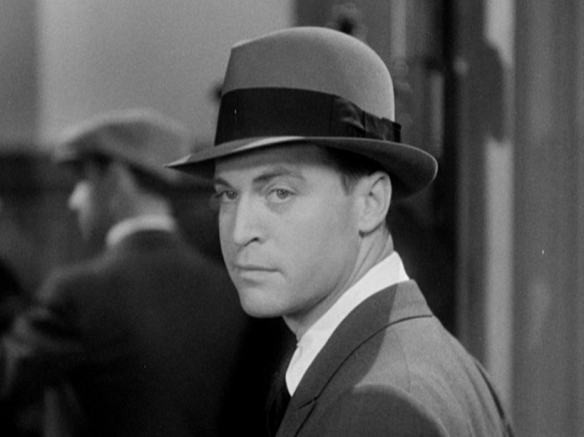“I know all the answers and I know what it’s all about. I found out that the only thing worthwhile is dough—and I’m gonna get it, see?”
—Blondie Johnson
Dames hardly ever call the shots in gangster films. Sure, they wield sexual power over their mobster boyfriends or husbands and occasionally get to plug some poor dumb sap, but they’re rarely in charge as the legitimate boss of a racket. And, unfortunately, when they are giving orders, the situation usually gets played for kink or camp. Noir offered plenty of domineering roles for nasty women running the show, although usually from behind the scenes, but classical gangster pictures, especially the first talkie cycle of the 1930s, remain mostly an old boys’ club.
Blondie Johnson, however, is a whole different animal. In this 1933 crime film (impossible to find until Warner Archive released it), a woman does take the reigns of an operation. She does so not because she’s hot to trot—she keeps men at an arm’s length—but because she’s got brains, guts, and commands loyalty from men and women alike. If this flawed film fails to live up to what I want it to be, it still makes for an intriguing 67 minutes of viewing if, like me, you love gangster films or pre-Codies.
We all know and love Joan Blondell as Miss pre-Code Cheekiness, a sassy, curvaceous babe out to get what she can and have a little fun in the bargain. So, in a way, Blondie Johnson, a small-time chiseler turned racketeer queen, might not seem to tug too hard at the underpinnings of her star image. She really just takes her tough, but voluptuous chick routine and teases it out to an extreme. This female kingpin (queenpin?) comes across not as a campy bitch goddess, but rather as the logical extension of every pre-Code working girl. She rolls with the big boys, gets them out of jams, and, before you know it, she makes a few decisive moves and ends up on top of the world.
The movie opens in a very un-gangster-like manner with Blondie waiting for unemployment aid. Glamorous, twinkly eyed Blondell hardly looks like herself, as though a pall had been cast over her usually winsome face.
Her mother is sick, dying, and she needs the money desperately. We all feel like we’ve been punched in the stomach when she gets turned down since she quit her previous job as a laundress—because the boss couldn’t keep his hands off her.
Well, if that’s not a bad enough day, Blondie comes home to find the doctor waiting with bad news. Her mother’s dead. She howls in desolation and crumples by the body.
In the next scene, a priest and a city magistrate are essentially trying to explain to her why she should accept the hard knocks that life deals her—including getting evicted, losing her mom, and dealing with predatory employers. There are two ways to make money, the priest tells her. “Yeah, I know.” She sneers, rejecting his irrelevant invocation of right and wrong. “The hard way and the easy way.” We understand that the opening trauma steeled this average girl into something determined and dangerous. Just as Baby Face quotes Nietszche, ol’ Friedrich’s “will to power” carries on in Blondie, too. We discern it in the feverish glow in her eyes.
Interestingly, whereas movies like Little Caesar, The Public Enemy, and Scarface never set out to explain why their protagonists become gangsters, apart from the obvious greed and ambition, Blondie Johnson introduces its heroine as a wronged woman. Director Ray Enright and writer Earl Balwin take pains to establish Blondie as a poor girl who really did try to live honestly in a society that makes a dignified existence impossible for down-on-their-luck women, especially.
“Well, the social services network let me down. I think I’ll turn to a life of crime.”
When a woman turns to crime, the producers no doubt assumed, we need to give her a reason, otherwise she’s a gutter snipe. Society does owe Blondie. She didn’t set out on the path to crime because of a desire for swag or authority: she did it because the sheer indifference of the world taught her that, if nobody will take care of you, you have to take care of yourself. I find that rationale a little sexist—a woman might aspire to be a Napoleon of crime for reasons other than economic necessity. But, hey, if it’s what they needed back in 1933 to get Joan Blondell to play a peroxide gangster, so be it.
Cut to Blondie shortly after her ordeal. She’s a totally different woman.
Tricked out in a stylish velvet dress and a sporty cap, she obviously chiseled some money out of someone… although it’s left to our imagination just how she did. In 1933, Photoplay magazine even went so far as to run promotions for Blondie Johnson based on the fashionable outfits worn by its eponymous girl gangster.
But the clothes don’t make the gal—the attitude does. From the slinky, yet proud posture of this dame as she calls for a cab with a come hither nod, we recognize how the abandonment of a little thing called morals has liberated her.
Enlisting the help of a dorky, squeaky-voiced cab driver (Sterling Holloway, who else?), Blondie pulls a small-time sympathy swindle. Waiting outside speakeasies, she cries and pretends to be a little lady deserted by her boyfriend because she wouldn’t sleep with him, now stranded and in need of taxi fare to get back to her job before she gets fired. Ironically, the woman who was wronged in real life ends up making money off of suckers by playing the victim, by staging and feigning a woman’s plight.
“Oh, sob, sob! I seem to find myself in distress!”
“I hate to see a dame in distress. Especially with pins like those.”
Problem is, the first mug she fools happens to be notorious gangster Danny Jones, played by an affably smug Chester Morris and his knife-blade profile.
Danny bumps into her later that night at a posh hotel where she’s dining on the money she collected from a gallery of suckers and, realizing he’s been taken in, he steps on her foot and prepares to repossess her winnings.
Using her quick wit and a few well-placed self-defense moves, Blondie manages to defuse his temper and convince him that she’s a “smart dame” who could prove a valuable asset.
So, he takes her to a hotel room for a drink. And here’s where the movie gets really interesting—we all prepare for the old pre-Code fade-out as Danny and Blondie become lovers. But no!
Blondie holds true to the code of the Corleone family: “It’s not personal. It’s business.” She carefully excludes the possibility of any fringe benefits to her and Danny’s mutual interests. Chester Morris and Blondell have a great chemistry together in this scene of back-and-forth attempts to soften the other up: she wants work in his syndicate and he wants, well, what men usually want in a hotel room after a couple of drinks.

Their snappy negotiations present a sort of gangster version of the famous pickpocketing scene between Marshall and Hopkins in Trouble in Paradise. He pays her for a job—corrupting a jury to swing a member of the gang out of prison—but asks for some sugar in return. She throws the money in his face and storms out.
He calls her back and she tells the story of her life, including the doleful tale of a sister who died from an illicit abortion. Always the optimist, Blondie ends her speech with a vow to get even with life: “This city’s gonna pay me a living!”
Just when we think things are getting grim, Danny agrees to let Blondie have a proper chance on equal terms, but then counts his money. Even in her fit of high temper, Blondie pocketed some of the money she seemed to refuse. Stunned by her brazenness and slight of hand, Danny stares, as Blondie coyly raises a glass to their platonic partnership.
As usual, there’s some division in the gang. Danny wants to bail his friend Louis out of jail while the big boss isn’t keen on the idea, since he doesn’t want Danny (really a lieutenant gangster) to make a play for power. That’s where Blondie comes in as a peroxide Lady Macbeth, lending Danny some of her own brass cajones to move ahead with a cunning courtroom drama.
In perhaps the best scene in the film, Blondie saves this big-time gangster Louis from a sure conviction by pretending to be his demure, pregnant fiancée—leaping up from the defendant bench to embrace him!
She wins sympathy by delivering a bravura performance, smacking of screwball comedy as much as gangster humor. Collapsing in Louis’ lap and heaving sobs of crocodile tears, she looks up at him surreptitiously and grunts, “Kiss me, you mug!” He does. And wins an acquittal.
After that, Blondie has won a place as part of the gang—but an uncomfortable one. She defies categorization. She’s not a moll, since she didn’t sleep with anyone to get there, nor can she ever fully be one of the boys.
In fact, no sooner does she attend the inevitable gangland banquet to celebrate Louis’ release (and lets Danny take all the credit) than the big boss gives the word that he doesn’t want Blondie around. Blondie doesn’t take to that news too well.
She pushes Danny to take over the operation. He almost gets killed for trying, but a few of his men, under Blondie’s direction, get rid of the big boss. And Danny’s suddenly in charge. He has a swanky deco office, a chorus girl as his playmate, and is getting fitted for new suits in the office. (Apparently having two egregious “nance” tailors fuss over you, the same ones from The Public Enemy, was the quintessential sign that you had arrived in the 1930s.)
But this is just the beginning of Blondie’s problems. You see, as much as Blondie likes and even comes to love Danny and abets his rise to power, Danny doesn’t appreciate the fact the he owes it all to a woman who really does all the driving. So he decides to ship her off to another racket. Now, the script doesn’t delve into what his plan actually was, but I think we’re to infer that he either tried to have her killed or at the very least sold to another racket, perhaps as a prostitute. Blondie pushed him away a little too much, so he double-crossed her.
Don’t ever mix business and horizontal kissing.
Still the wronged woman, in spite of all her leadership, Blondie doesn’t like that. Nor does the crack team of molls and mugs. They recognize that it’s her brains and nerve that made their insurance racket what it is. For instance, in one particularly amusing interlude, Blondie works with two other molls to impersonate a rich heiress and intimidate a bunch of cash out of a bogus personal injury case.
So, instead of cutting Blondie out, the gang backs her up and give Danny—who’s worn them out with his poor judgement, extravagance, and arrogance—the kiss-off. Now, Blondie’s at the top. Perched amidst modernistic, urban finery, she orchestrates her shady protection/insurance mob with competence and aplomb, appearing more as a sophisticated businesswoman than a scion of gangland.
But Danny still rankles like a thorn in her side. He knows too much and could sink the whole organization. When one of Blondie’s confederates reports that a disgruntled Danny is going to spill all to the cops, she reluctantly orders his execution and two henchmen go off to dispatch the death sentence.
Brrring! Brrring! Phone call for Blondie Johnson! It turns out Danny didn’t divulge any information to the police. Remorse sets in. Holding a picture of Danny (yeah, I tend to keep around large, framed portraits of guys who screwed me over, too), Blondie decides that she can’t just kill him off like that.
At the last moment, she caves in to her humanity and goes rushing to save the man she loves.
She arrives too late. Bang. Bang. We hear the off-screen shots and think the deed’s been done.
Danny’s on the floor, still alive, but full of her henchman’s lead. Sirens sound. Blondie could get away, and Danny urges her to save herself, but she stays, cradling the man who did her wrong. They confess their love as the police draw near.
Defeated by love and nabbed by the cops, Blondie stands trial and gets six years hard labor. (Yes, it’s lame. I didn’t write it. If I had, Blondie would’ve joined forces with Stanwyck and Teresa Harris from Baby Face and—what the Hell—King Kong. Together they would’ve ruled the world. Anyone wanna greenlight that?)
As Blondie gets hauled out of court, she passes Danny, also about to be tried and taken to jail, meets her and they share a tender moment, promising to wait for each other.
The final shot of Blondie Johnson, this uncertain, wistful medium close-up reminds me of a lot of unresolved, ambiguous final shots like this from 1930s movies (I am a Fugitive from a Chain Gang comes to mind) that hint at the unresolved fates of people we’ve come to care about deeply.
’Twas beauty killed the beast, but in this case,’twas a beast (Chester Morris) that brought Blondie down. As much as that bothers me, the true emotional sacrifices of running a racket that we witness in Blondie Johnson definitely foreshadow the many heart-wrenching betrayals of The Godfather: Part II. Ruthlessness exacts a price on the one who’s ruthless, too.
In his brief analysis of this film, Thomas Doherty claims that, because she’s a woman, Blondie gets a chance at rehabilitation and a little bit of hope, whereas a male gangster would’ve been shot down and finished with. I concede the point, but disagree with the interpretation. I think that the punishment dished out to Blondie is a lot worse. Better to go down in a machine-gun burst of brilliance than have to live through a long prison sentence which, frankly, might kill her anyway. There’s no romance to this conclusion. This is the way the world ends. Not with a bang, but with a tear in Blondell’s big pop eyes.
Blondie is a fascinating film for its attempt to reformat the template of the gangster picture with the added sexual stakes of a woman trying to climb the gang ladder.
The occupational hazards of working in a male-dominated industry.
The film starts to hints at the female hierarchy behind the mob though the political dynamics between the gun molls that we see: Claire Dodd as Gladys, the priority blonde mistress, passed from one gang head to another, Mae Butsch as Mae, the matronly has-been moll who acts as a front from time to time, and Japanese-American Toshia Mori as Lulu, another beautiful lady coasting through the racket, mostly in a servile role, perhaps due to her ethnicity.
It’s subtle but the women get more of a voice under Blondie and her supporters go with her to the top—as suggested by this skyscraper low angle. Molls of the world, unite!
The film criminally underuses these women, but they do come across as more real than the silken ladies of many a 1930s gangster flick in that they’re not in the racket for thrills or luxury, but for survival. It’s a kind of job in a time when jobs weren’t forthcoming. It’s also interesting to watch Lulu and Mae grow into slightly more important, commanding babes in Blondie’s company, as though her strength set an example for them.
I wonder if real ’30s working girls felt the same about this unconventional female role model. Even if she ends up in the hoosegow, I hope that Blondell’s effulgent badassery inspired more than a few chicks to go a little Blondie on an unfair world.
Nevertheless, I wish that Blondie Johnson had ascended to a higher plane of cinema instead of remaining a somewhat formulaic jumble of missed opportunities. It’s a film that generates a lot of regret for me. I wish it had been less of a plodding women’s picture and more of gangster flick—or even an revolutionary women’s picture. Like Baby Face with guns. I wish that it had a more lucid script, a few more gunshots, and someone like William Wellman or Howard Hawks at the helm. With its good cast and such an innovative concept, in better hands, it could have smashed into our consciousness as a founding gangster film, like Little Caesar or Scarface. And set a precedent for gangster movies that let a dame run the show.
She’s the show. He just watches and learns.
As is, Blondie Johnson is well worth watching just to savor how Blondell, a wisecracking sidekick no more, rises from nothing to hold supreme control over the situation. In 1933, Motion Picture magazine was prompted to ask if Blondell was being groomed as a kind of female Cagney. She exudes a warmer version of his alpha male magnetism and moxie. Alas, she doesn’t call the shots for long, but it’s damn fun while it lasts.
This post is part of the #scenesofthecrime blogathon. Check it out, see?
























































